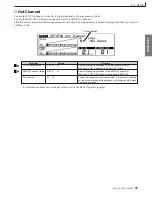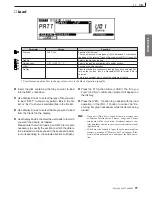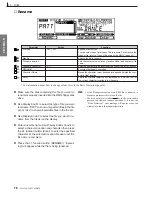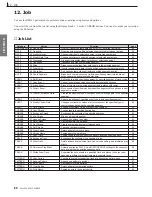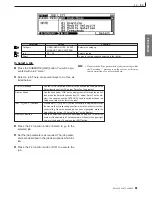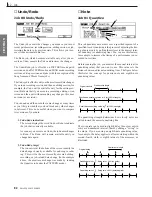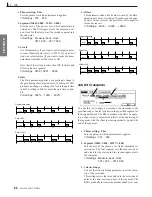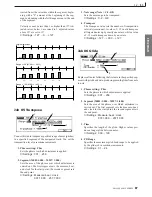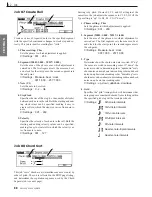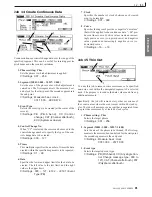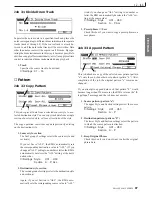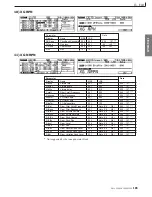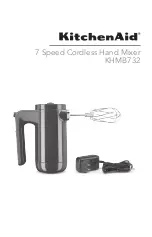
88
RM1x SEQUENCE REMIXER
PA
TTERN MODE
12. Job
Job 07 Create Roll
1
3
2
4
5
Creates a series of repeated notes in the specified segment
with the specified continuous changes in clock step and ve-
locity. This job is ideal for creating fast “rolls.”
1. Phrase setting: Phrs
Sets the phrase to which adjustment is applied.
■
Settings : 001 ... 256
2. Segment (M001:1:000 ~ M257: 1:000)
Sets the area of the phrase over which adjustment is
carried out. The first segment sets the measure, beat,
and clock for the start point; the second segment sets
the end point.
■
Settings : Measure: beat : clock
001:1:000 ... 257:1:000
3. Note (C3)
Sets the note to be rolled.
■
Settings : C-2 ... G8
4. StepClock
Specifies the size of the step (i.e. the number of clocks)
between each note in the roll. Both the starting and end-
ing clock values can be specified, making it easy to
create rolls in which the step size varies from note to
note.
■
Settings : 001 ... 999
5. Velocity
Specifies the velocity of each note in the roll. Both the
starting and ending velocity values can be specified,
making it easy to create rolls in which the velocity var-
ies from note to note.
■
Settings : 001 ... 127
Job 08 Chord Sort
1
3
2
4
This job “sorts” chord events (simultaneous note events) by
order of pitch. The sort is reflected in the EDIT page listing,
and determines the separation sequence used by the Chord
Separate job (see next page).
Sorting is by pitch. If notes E3, C3, and G3 all begin at the
same time, the job adjusts the sequence to C3, E3, G3 (if the
Type setting is “up”) to G3, E3, C3 (if “down”).
1. Phrase setting: Phrs
Sets the phrase to which adjustment is applied.
■
Settings : 001 ... 256
2. Segment (M001:1:000 ~ M257: 1:000)
Sets the area of the phrase over which adjustment is
carried out. The first segment sets the measure, beat,
and clock for the start point; the second segment sets
the end point.
■
Settings : Measure: beat : clock
001:1:000 ... 257:1:000
3. Type
Determines how the chord note data is sorted. If “up”
the notes are sorted in ascending order. If “down” the
notes are sorted in descending order. “up&down” sorts
chord notes on downbeats in ascending order and chord
notes on up beats in descending order. “down&up” sorts
chord notes on downbeats in descending order and chord
notes on up beats in ascending order.
■
Settings : up, down, up&down, down&up
4. Grid
Specifies the “grid” timing which will determine what
note groups are considered chords. Notes falling within
the specified grid step will be treated as chords.
■
Settings :
32nd-note intervals
16th-triplet intervals
16th-note intervals
8th-triplet intervals
8th-note intervals
Quarter-note-triplet intervals
Quarter-note intervals


